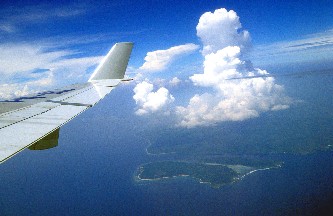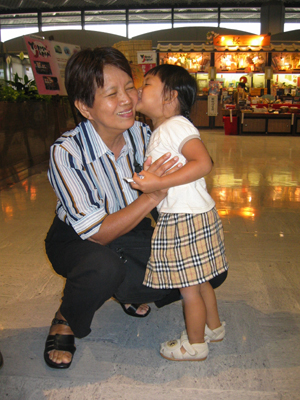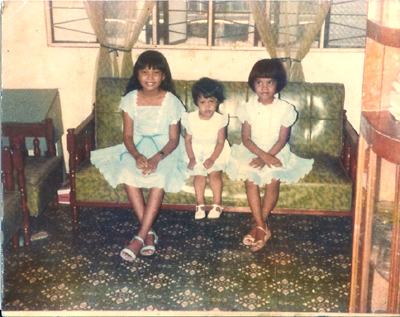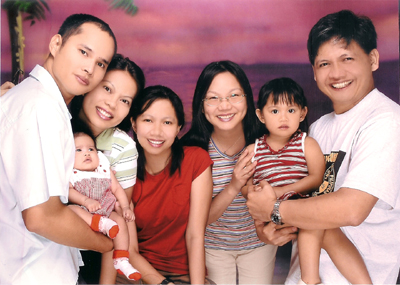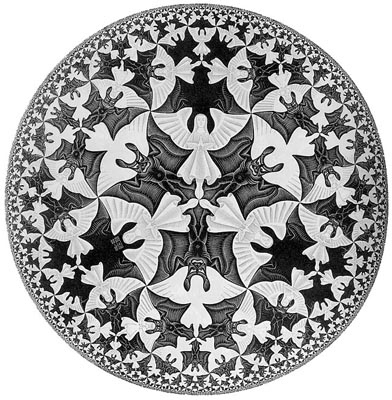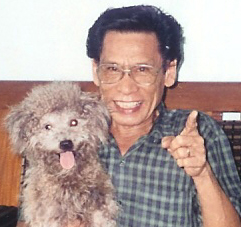I vowed not to let this day pass without writing anything here. Today happens to be the first death anniversary of Daddy. When Aya was born, my life was changed forever. When Daddy died, my perspective about life was changed forever. There is a reason why our lifetimes are finite.
I am posting here an essay which I wrote a few months after Daddy died.
To live again
By Katherine Develos Bagarinao
He gave me my name. He called me “Katherine,” after Catherine Marshall. When I was about to be born, he was reading a book by Catherine Marshall, “To live again,” who wrote it after her husband Peter Marshall died. Family members have always called me “Lilet,” the nickname my cousin gave me. But as far as I could remember, my dad had always called me “Katherine” or simply, “Anak,” depending on the mood or circumstances. “Anak” was reserved for affectionate moments; “Katherine” seemed to be more favored in occasional bursts of exasperation.
He was no ordinary person. One can easily notice how we, his daughters, towered over him. Standing at only around 5 ft tall, people often wondered how someone like him would have daughters much taller than him, kanino ba raw kami talaga nagmana? He was afflicted with kyphosis (curvature of the spine) at a very young age, and way back in the 1940s, right smack in the middle of the World War II, medical treatment for such a kind of disease was virtually unheard of in the obscure rural town of Hamtic, Antique. Not that such a treatment could even be afforded by their family at all. Dad could only recount the pain he felt, how he heard his bones “cracked” when the “manghihilot” tried to push and press the growing lump at his back. Then his mother died of throat cancer, leaving all three of them without maternal love for the rest of their lives. His father, however, was a tough, hard-hearted man who did not spare any pities or compassion for his only son. He made it clear that he wanted no freak child. Sayang na bata raw siya. Dad received both verbal and even further physical abuse from one of his uncles who could not accept his being different. It was as if someone like him would be immune to whips and bad language. One time, amidst the protests by his eldest sister who tried in vain to protect him, Lolo in his anger tied Dad’s feet together, hung him upside down and whipped him. Daddy never recounted to us what spurred Lolo to do such a thing, but whatever the reason was probably did not deserve such a cruel treatment, especially for a child. He ran away from home, and went to stay alone in a mountain hut in a remote place called Badiangan all by himself. He felt lonely, unwanted, and most of all, unloved. He vowed to prove them wrong. The freak child they all considered “only be a waste of food” would someday prove them all wrong.
Daddy survived that ordeal in his life. The truth is, I have never met anyone more self-made than him. He left the province and went with his elder sister to Manila to try his luck. He worked his way through college, taking fine arts at FEATI University while working in the literature department of The Salvation Army in Leon Guinto. Though he was not educated in journalism, he managed to become the editor-in-chief of The War Cry, the official publication of the organization. Daddy became a painter and illustrator, gardener, businessman, writer and journalist, poet, Bible teacher, and even boxing trainer – all in one! The one thing he detested most of all was for people to look at his deformity as some sort of disability. Whatever “normal” people could do, he wanted to surpass. “Always do your best,” was the oft-repeated phrase as he admonished us to excel and strive beyond what we thought we were capable of doing. He challenged us. “If I had normal bodies like you do, I’d be doing more than you’re doing now.” The day when I first received my medal for academic excellence in elementary school, he was probably the happiest parent there among the crowd. Each time I won a competition in school I would proudly show off each medal or certificate to my dad, who would then challenge me to “show them what stuff the Develos is made of.” But each time he refused to go up the stage with me during recognition ceremonies. He always wore his best clothes and combed his hair in that pompadour style. He carried himself with the air and pride of someone who had received the same honor and recognition. But not even once was he ever seen with me on stage. Not even with my sisters, during their turns. He hung all our medals and displayed our trophies at home. It didn’t matter that he was not honored at the stage. It’s enough that we were proud bearers of his name.
He showered on all of us the love and affection that he was deprived of when he was growing up. He would pamper us and not let us do any household chores, especially if we were studying or doing homework for school. Our mother would always scold him for letting us get away from such responsibilities, but he would always chide her – what is so important about washing the dishes or cleaning the house compared to gaining knowledge? “Wala akong ibang maipapamana sa inyo kundi edukasyon,” my Daddy would always remind us.
There never was an idle moment for Daddy. To our young eyes it seemed as if he were always rushing to accomplish so many things at the same time. He did everything from raising chickens in our backyard to organizing a boxing event in Antique. For Daddy, time must not be wasted; every day he would be found reading a book in his study, writing something using his rusty old typewriter, or discussing Biblical concepts with his students (disciples, we would call them). During his brief stay in Japan, he delivered sermons in the Sunday fellowships and led the discussions in weekly bible studies. He wrote a short story, Sad-to Anay, begrudgingly using my computer at home, and promptly submitted it for publication in Hiligaynon when he returned to Manila. The gist of the story? It’s about a little boy who grew up alone, and against all odds, became a self-made man and had a family. His children grew up happy, finished their studies, and are on their road to eventual success in life. This was his revenge, his struggle that has borne fruition, his ultimate achievement in life. He told me more than once, puede na akong mamatay anytime, seeing that you’re all on the right tracks. To which I always retorted, “No, Daddy, you’ll grow up to be an old man and see all your apos.” “No, he always replied, “I don’t want to expect more than a few years.”
The last time I ever saw him alive was during my sister Karen’s wedding in September of last year. Our last family picture was that of us in the garden, Karen in her wedding garb, us in our finest gowns and Daddy in his finest barong. He used the same barong that he wore during my wedding, two years earlier. The next time I saw him, he was lying peacefully inside a coffin at Samson funeral homes at Imus, Cavite. He had been struggling with pains due to his kidney since February (2004), only to finally succumb to pulmonary infection in early May. He was cremated two days after we got home. This was his final wish, that his remains be reduced to nothing but dust and ashes. It is as if he wanted to punish the very bones of his affliction to signify his final escape to freedom. In heaven I will have a glorified body, I remember him telling us during our Bible devotions.
When I finally had to chance to talk to his attending physician, he told us that Daddy was lucky to have reached such an age (he was 65), and very fortunate to see all his daughters grown-up already. It was bad enough for old people to get lung infections with their immune systems down; kyphotic patients don’t even stand a chance at recovering. “It was meant to happen,” was all he could tell us.
Where does one find the courage to live again after the death of a beloved parent? My father, to whom I’ve dedicated my life’s achievements, is now gone. Where does one find the heart to go on? Going through my dad’s things afterwards, I found something that I’ve totally forgotten about all these years – every single one of my certificates received in elementary and high school, were carefully collected and kept in a folder. No parent was ever prouder.
In his last letter to me, he wrote the lyrics of a song he had often sang to us when we were children:
The things of earth will dim and lose their value
If we recall, they’re borrowed for a while
And things of earth, that cause the heart to tremble
Remembered there will only bring a smile
But until then, my heart will go on singing
Until then, with joy I’ll carry on
Until the day, my eyes behold the city
Until the day, God calls me home
As a child, I could not understand why Daddy would sing this song with so much passion. As a child, I thought that parents live forever.
As an adult and a parent myself, now I fully understand.
As I stood at the podium to talk about God’s faithfulness in our lives, I looked over where my Daddy was lying and I understood what he had been telling me all these years.
There is only one way to live again – and that is to know, to affirm, and to live with the assurance that in spite of the temporal things here on earth, there exists the ultimate hope of the life beyond. While death necessarily punctuates our existence here on earth, there is something that death cannot conquer. That is something that I learned from Daddy as well. It is the same hope that I will give to my daughter when my time comes.
Indeed, we can only begin to live if we are prepared to die.
– June 2, 2004
